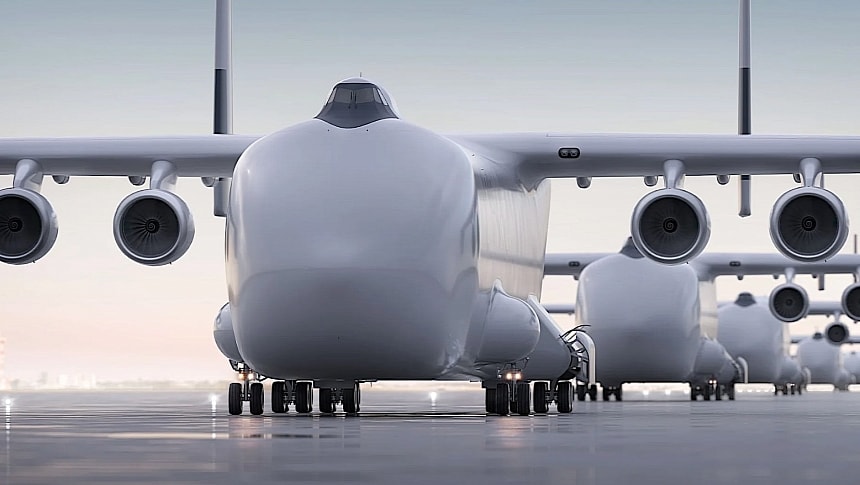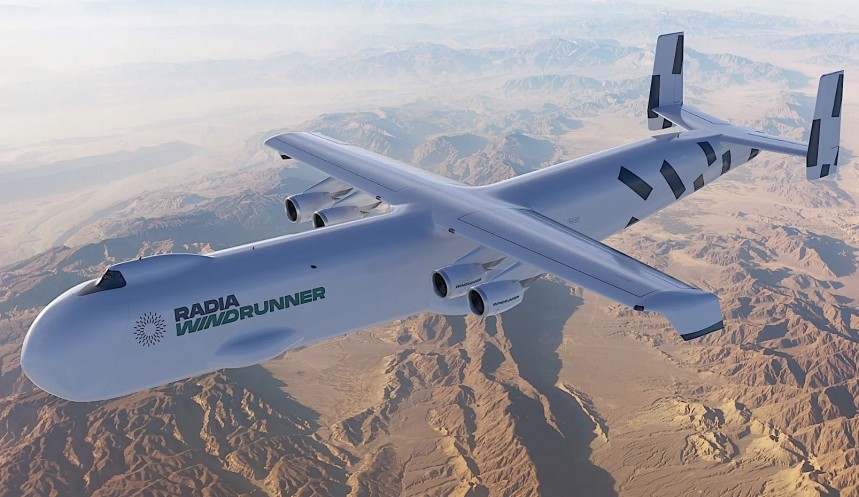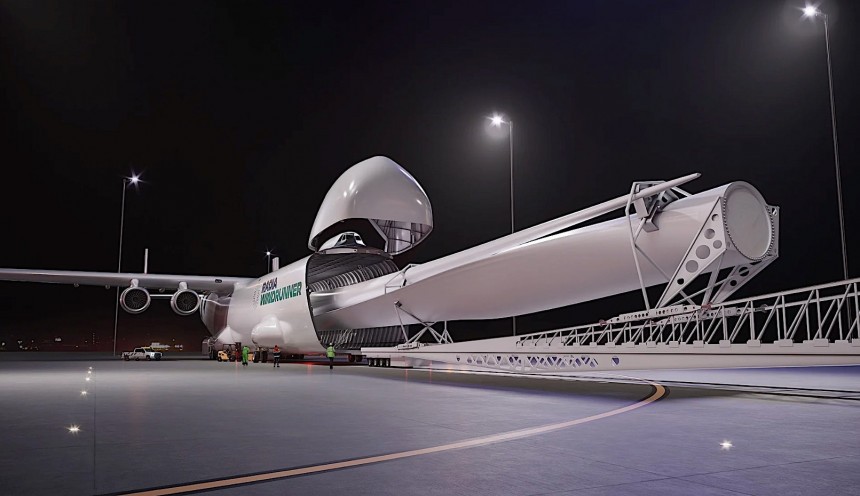Businesses are usually born out of necessity. In a simplistic way, when someone believes there is or will be a need for a product or service, they'll move to provide that. If that need turns out to be real, a market will be created and others will join in. If not, said business will most likely go under. It's too early to say if there will ever be a market for a cargo plane capable of carrying wind turbine blades.
As the world moves toward greener and greener energy at an accelerated pace, the generation of electricity from wind is increasing in traction. Wherever possible, wind turbines are installed, their massive blades turning to transform a force of nature into something civilization as we know it would not exist without.
Nobody knows for sure how many wind turbines are presently operating in the world. At the beginning of last year, there were estimates that the number would be around 400,000, which would generate a combined 840 GW of power.
These things are so gargantuan in size that their simple installation is a feat of incredible engineering. And so is the transport of a turbine's components to where they're meant to be.
A wind turbine generally comprises a tower and a nacelle to hold the rotor, hub, drive train, and generator. All of these would be useless if it weren't for the blades which spin under the power of the wind. And it is these blades, or more precisely their transportation to wind farms, that has a group of people believing there will be a need for a specialized means of transport in the not-so-distant future.
As it stands today a wind turbine blade is roughly 35 meters (116 feet) long on average. That makes it hard to transport, but not impossible (not even for longer blades), and most of the time road trucks are used for the task.
But remember how I mentioned earlier the world is moving toward greener and greener energy at an accelerated pace? In part that accelerated pace will mean increasing the length for these blades, as the longer they are the more power they will be able to generate from thin air.
There are estimates that in the not-so-distant future these pieces of hardware will grow to be over 328 feet (100 meters) long, and that will make their transportation anywhere virtually impossible. Or will it?
Enter the WindRunner, a type of aircraft no one has ever seen before, which will be built with the specific task of moving very long wind turbine blades.
The plane is the brainchild of a company called Radia. Established in 2016, the company brings together people from MIT and Boeing, among other places, and promises to simply revolutionize how air transportation of oversized cargo is done.
The Windrunner is supposed to be the largest aircraft in the world in terms of both length and volume. At 356 feet (108 meters) long it will dwarf even the now-destroyed Antonov An-225 Mriya (276 feet/84 meters) or the now-defunct Ekranoplan (302 feet/92 meters).
Volume-wise, the aircraft will be able to accommodate 272,000 cubic feet (8,200 cubic meters) of cargo, which by all intents and purposes is a hell of a lot more than what the Airbus BelugaXL has to offer (/78,000 cubic feet/2,209 cubic meters).
With such a large space built-in, the WindRunner should be capable of transporting wind turbine blades that are as long as 344 feet (105 meters). It should carry them to altitudes of as much as 41,000 feet (almost 12,500 meters), and for distances as long as 1,240 miles (1,996 km).
The plane will have a wingspan of 261 feet (80 meters), with each wing carrying two engines of yet undisclosed provenance. They will be powerful enough though to allow the aircraft to lift a total of 160,000 pounds (72,575 kg) of cargo and travel at speeds of Mach 0.6.
Ok, so all of the above numbers are pretty impressive, but they would be useless if the WindRunner were only able to fly from airport to airport, because wind turbines are not usually installed near such facilities. So the plane is being designed with the ability to take off and land from and on very short runways.
We're told that somehow (perhaps because of its rather strange shape) the thing will be able to depart and arrive on runways that are just 6,000 feet (1,800 meters) long. More importantly, they don't have to be proper runways, but can have packed dirt for a surface.
All of the above may sound a bit too futuristic, but the WindRunner may be closer than we think. After securing 100 million in funding from various sources not long ago, Radia says it is "more than halfway through the time required to design, build and certify an aircraft." Even so, we're not given any estimates as to when we are to expect the aircraft to fly for the first time.
Nobody knows for sure how many wind turbines are presently operating in the world. At the beginning of last year, there were estimates that the number would be around 400,000, which would generate a combined 840 GW of power.
These things are so gargantuan in size that their simple installation is a feat of incredible engineering. And so is the transport of a turbine's components to where they're meant to be.
A wind turbine generally comprises a tower and a nacelle to hold the rotor, hub, drive train, and generator. All of these would be useless if it weren't for the blades which spin under the power of the wind. And it is these blades, or more precisely their transportation to wind farms, that has a group of people believing there will be a need for a specialized means of transport in the not-so-distant future.
As it stands today a wind turbine blade is roughly 35 meters (116 feet) long on average. That makes it hard to transport, but not impossible (not even for longer blades), and most of the time road trucks are used for the task.
But remember how I mentioned earlier the world is moving toward greener and greener energy at an accelerated pace? In part that accelerated pace will mean increasing the length for these blades, as the longer they are the more power they will be able to generate from thin air.
Enter the WindRunner, a type of aircraft no one has ever seen before, which will be built with the specific task of moving very long wind turbine blades.
The plane is the brainchild of a company called Radia. Established in 2016, the company brings together people from MIT and Boeing, among other places, and promises to simply revolutionize how air transportation of oversized cargo is done.
The Windrunner is supposed to be the largest aircraft in the world in terms of both length and volume. At 356 feet (108 meters) long it will dwarf even the now-destroyed Antonov An-225 Mriya (276 feet/84 meters) or the now-defunct Ekranoplan (302 feet/92 meters).
Volume-wise, the aircraft will be able to accommodate 272,000 cubic feet (8,200 cubic meters) of cargo, which by all intents and purposes is a hell of a lot more than what the Airbus BelugaXL has to offer (/78,000 cubic feet/2,209 cubic meters).
With such a large space built-in, the WindRunner should be capable of transporting wind turbine blades that are as long as 344 feet (105 meters). It should carry them to altitudes of as much as 41,000 feet (almost 12,500 meters), and for distances as long as 1,240 miles (1,996 km).
Ok, so all of the above numbers are pretty impressive, but they would be useless if the WindRunner were only able to fly from airport to airport, because wind turbines are not usually installed near such facilities. So the plane is being designed with the ability to take off and land from and on very short runways.
We're told that somehow (perhaps because of its rather strange shape) the thing will be able to depart and arrive on runways that are just 6,000 feet (1,800 meters) long. More importantly, they don't have to be proper runways, but can have packed dirt for a surface.
All of the above may sound a bit too futuristic, but the WindRunner may be closer than we think. After securing 100 million in funding from various sources not long ago, Radia says it is "more than halfway through the time required to design, build and certify an aircraft." Even so, we're not given any estimates as to when we are to expect the aircraft to fly for the first time.












